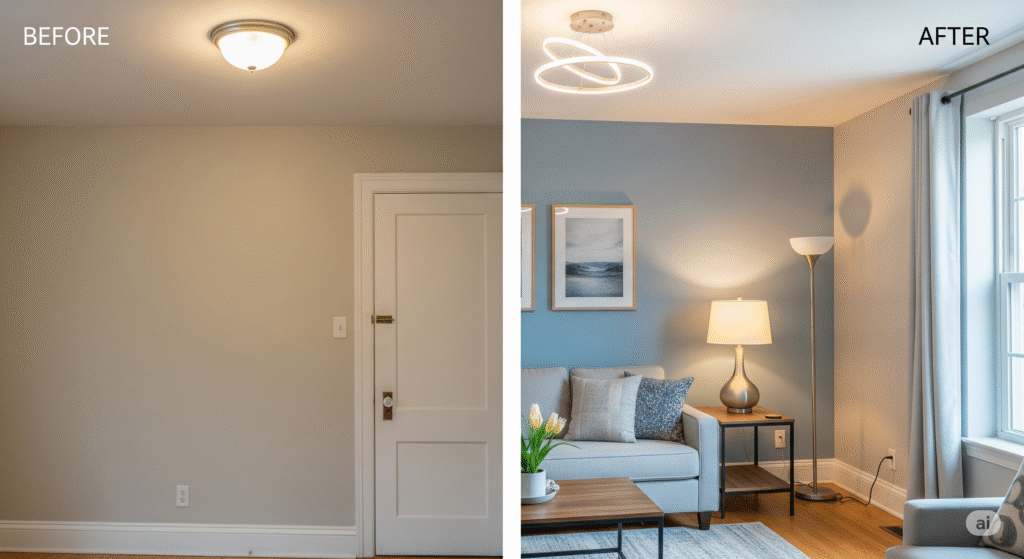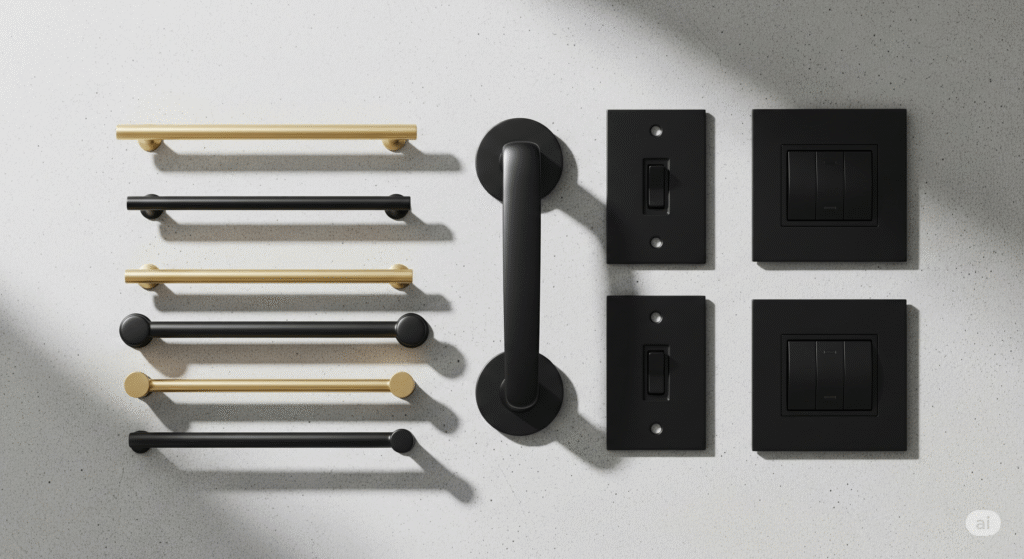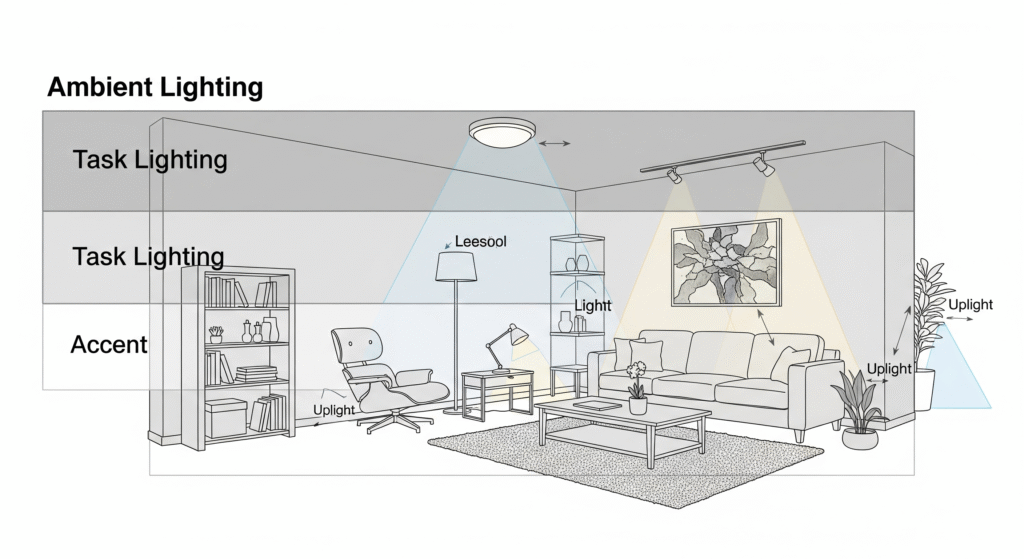How To Give Your Old-Looking Home a New Spin
If your home feels tired or stuck in another decade, you don’t need a full renovation to make it feel fresh. With the right sequence—paint, light, texture, storage, and a few smart swaps—you can transform the look and function of your space without blowing the budget. This guide walks you through a high-impact strategy that balances style, durability, and resale value.

1) Quick Wins That Change Everything
- Deep clean + declutter first. Nothing dates a home more than dust lines, scuffed switch plates, and overcrowded shelves.
- Unify your color story. Pick 2–3 neutrals + 1 accent and repeat them room-to-room for a cohesive feel.
- Replace the items you touch daily: door levers, cabinet pulls, faucet aerators, showerheads, and switch plates. The tactile upgrade makes the whole house feel newer.
- Style your entry. A new doormat, door hardware, and a potted plant create a “fresh” first impression.

2) Paint Strategy That Modernizes (Without Repainting Everything)
Best neutral base hues (timeless + light):
- Warm: soft greige, creamy beige, oatmeal white
- Cool: pale taupe, soft dove gray
- Crisp trim: clean white or off-white with a satin/semi-gloss sheen
High-impact, low-effort paint moves
- Feature wall or niche. Use a richer tone (ink blue, forest green, clay terracotta) in one area to add depth.
- Ceiling in eggshell. A slightly lighter tint than walls draws the eye up and makes rooms feel airy.
- Interior doors in a color. Charcoal or muted blue on doors = instant boutique-hotel energy.
- Paint dated tile or brick (proper prep!). Masonry primer + durable enamel can extend the life of a fireplace or laundry backsplash.
Pro prep tips
- Fix hairline cracks with patching compound, sand smooth, then prime.
- Sample swatches on two walls and view morning/evening to confirm undertones.
3) Lighting: The Fastest Way to Make Any Room Look New
Old homes usually have a single overhead light. Modern spaces layer light: ambient + task + accent.

- Ambient: ceiling fixtures, flush mounts, or dimmable recessed lights.
- Task: table/desk lamps, under-cabinet strips in the kitchen, reading sconces by the sofa/bed.
- Accent: picture lights, LED strips behind shelves, toe-kicks under vanities, spotlighting plants or art.
Bulb choices that flatter
- 2700–3000K (warm white) for living/bedrooms; 3000–3500K for kitchens/baths.
- High CRI (90+) makes colors and skin tones look accurate.
- Put living areas on dimmers to extend mood range (movie night vs. reading).
4) Texture, Fabric & Color: Refresh Without Replacing
- Swap heavy drapes for linen, cotton, or light-filtering shades hung high and wide to elongate windows.
- Layer textiles: pair a neutral sofa with tactile throws (bouclé, knit) and patterned cushions in your accent color.
- Add architectural texture: peel-and-stick beadboard for kitchen islands, batten strips for a minimalist feature wall, or a cane insert on a dated cabinet door.
- Edit patterns smartly: choose one large-scale pattern + one small-scale + one texture to avoid visual noise.
5) Hardware & Fixtures: Small Parts, Big Impact
- Kitchen & bath: replace shiny, dated knobs with matte black, brushed brass, or satin nickel pulls that match your faucet tone.
- Switch/outlet plates: upgrade to screwless plates for a clean, contemporary look.
- Faucets & shower sets: choose simple silhouettes; single-handle faucets feel modern and are easier to use.
- Door hardware: lever handles in a consistent finish unify rooms.
Tip: Stick to two finishes per room (e.g., matte black + brushed nickel) to avoid a “parts bin” look.
6) Floors & Rugs: Affordable Ground-Up Refresh
- Refinish or screen-and-coat hardwoods if possible; it’s often cheaper than full replacement.
- Luxury vinyl plank (LVP) delivers a modern wood look, is water-resistant, and kinder on the budget than engineered hardwood.
- Rugs: go larger than you think—front legs of sofas and chairs should sit on the rug. Patterns hide wear in high-traffic zones.
7) Storage & Styling: Declutter, Display, and Hide Smart
- Built-ins on a budget: float simple box shelves or hex shelves (like yours!) in groupings for a custom look.
- Baskets + lidded boxes on open shelving keep daily clutter out of sight.
- Rotate decor seasonally. Keep only 30–40% of shelves filled; negative space looks modern.
- Entry station: wall hooks + slim console + tray for keys/mail = instant calm.
8) Smart Home & Energy Upgrades That Pay You Back
- Smart thermostats (learning or programmable) reduce energy spend and add resale appeal.
- LED everywhere. They last longer and cut consumption dramatically.
- Weatherstripping & caulk around doors/windows = quieter rooms and better temperature control.
- Water-saving fixtures: aerators, low-flow showerheads, dual-flush valves modernize feel and utility bills.
(Check local rebates—many areas subsidize smart thermostats and LED upgrades.)
9) Biophilic Touches: Bring the Outdoors In
- Low-maintenance plants: snake plant, pothos, ZZ plant, or succulents.
- Natural materials: jute rugs, oak shelves, stone-look planters soften modern lines.
- Daylight hacks: use mirrors opposite windows and choose light, matte finishes to bounce light around.
10) Layout Tweaks: Make Old Rooms Work Like New
- Float the sofa away from the wall and define zones with rugs.
- Create symmetrical pairs (lamps, side tables, art) for a clean, intentional look.
- Swap room roles if needed—make the brightest room your daily hangout.
- Kitchen triangle refresh: if you can’t remodel, rearrange small appliances so prep flow is: fridge → sink → counter → stove.
11) Budget Planner: Ideas by Price Tier
Under \$100
- New doormat, house numbers, and mailbox.
- Bulb swap to warm, high-CRI LEDs.
- Stylish cabinet pulls for a powder room or small kitchen run.
\$100–\$500
- Room repaint + new curtain panels + modern rods.
- Entry console + mirror + two baskets.
- Layered living room lamps (floor + table) on smart plugs.
\$500–\$1,500
- Refinish a small wood floor area or install a quality LVP.
- New bathroom vanity light + faucet + mirror.
- Closet system in the primary bedroom to reduce visible clutter.
\$1,500–\$5,000 (stretch goals)
- Appliance upgrades (start with the range hood or fridge).
- Replace multiple dated light fixtures house-wide.
- Add built-in shelving or a fireplace surround refresh.
12) 1-Weekend Mini Makeovers (Room-by-Room)
Living Room (8–10 hours)
- Patch/paint walls.
- Rehang curtains higher/wider; add dimmers.
- Re-arrange furniture; anchor with a larger rug.
- Style shelves: ⅓ books, ⅓ objects, ⅓ plants/empty space.
Kitchen (1 day)
- Degrease and paint walls/ceiling; install under-cabinet LEDs.
- Replace pulls and faucet; add peel-and-stick backsplash if appropriate.
- Curate open shelves with glass, wood, and greenery.
Bathroom (6–8 hours)
- New shower curtain/liner, towels, and bath mat in a cohesive palette.
- Swap vanity light and mirror; refresh caulk around tub/sink.
- Add over-toilet shelf with baskets for storage.
Bedroom (1 day)
- Paint a headboard wall; add matching side lamps.
- Upgrade bedding basics: crisp sheets, duvet insert, two good pillows.
- Install blackout liners or double-layer curtains for better sleep.
Curb Appeal (half-day)
- Paint the front door; polish or replace hardware.
- Trim hedges; add two planters with evergreens.
- Clean windows and power-wash the path.
13) Mistakes to Avoid
- Too many finishes. Limit metal finishes and wood tones to avoid visual clutter.
- Skipping prep. Paint and adhesive projects fail without proper cleaning, sanding, and priming.
- Rug too small. It makes rooms feel cramped.
- One giant overhead light. Layer lighting for a modern, cozy look.
- Buying before measuring. Tape outlines on the floor before ordering furniture or rugs.
14) Step-by-Step Action Plan
- Assess: Take photos of each room. Mark what looks tired: paint, lights, hardware, textiles.
- Choose a palette: 2–3 neutrals + 1 accent that works with your floors.
- Fix foundations: patch/paint walls; swap bulbs; deep clean.
- Layer lighting: add at least one task and one accent light per main room.
- Update touch points: cabinet pulls, faucets, switch plates, door hardware.
- Style & store: add baskets, edit shelves, and rotate decor.
- Elevate: rugs to correct size; curtains hung high and wide; mirrors to bounce light.
- Green it: plants, natural textures, and an outdoor refresh.
- Optimize: smart thermostat, weatherstripping, and water-saving fixtures.
- Maintain: quarterly reset—declutter, touch-up paint, launder slipcovers, refresh plant soil.
Pick the Right Colors for Your Modern Home: Expert Guide for 2025
FAQs
Q1: What’s the fastest update that makes the biggest difference?
Paint + lighting. Fresh paint corrects years of scuffs and color cast; layered, dimmable lighting makes everything—including you—look better.
Q2: Can I mix metal finishes?
Yes, but keep it intentional: one dominant finish (e.g., matte black) plus one accent (e.g., brushed brass). Repeat them at least three times in a space.
Q3: Are peel-and-stick products worth it?
Great for low-moisture areas and renters. Use quality brands, prep surfaces (clean, smooth, dry), and avoid direct stove/steam zones.
Q4: Which wall color works with warm wood floors?
Greige, creamy white, or soft taupe usually harmonize. Test swatches in different light before committing.
Q5: How do I make a small room look bigger?
Use light wall colors, larger rugs, leggy furniture, mirrors opposite windows, and ceiling-height curtains.
Q6: What are budget priorities if I can only do three things?
(1) Paint/patch, (2) bulbs + dimmers, (3) hardware and textiles (curtains/rugs/pillows) that unify the palette.
External Resources (For Further Reading)
- Energy-efficient lighting & appliances:
ENERGY STAR – Guidance on lighting, thermostats, and rebates: https://www.energystar.gov/ - Indoor air quality & safe renovations:
U.S. EPA (Indoor Air Quality at Home): https://www.epa.gov/indoor-air-quality-iaq - Historic finishes & surface prep (for older homes):
National Park Service Preservation Briefs: https://www.nps.gov/tps/how-to-preserve/briefs.htm - Practical DIY tutorials:
This Old House – Step-by-step guides: https://www.thisoldhouse.com/ - Paint color science & tips:
Benjamin Moore Color Advice: https://www.benjaminmoore.com/en-us/paint-colors/paint-color-advice
Sherwin-Williams Color Resources: https://www.sherwin-williams.com/en-us/color
Final Take
Modernizing an older home is about sequence and consistency, not expensive brand-new everything. Start with paint and light, update the things you touch daily, layer in texture and plants, and keep your palette tight. The result is a home that looks new, feels comfortable, and works better for the way you live—without a gut remodel.
